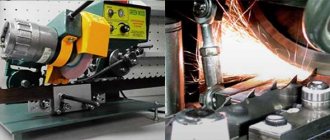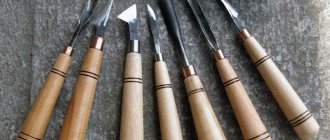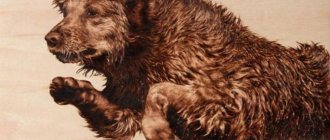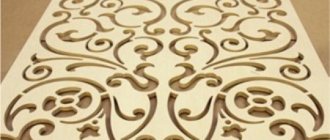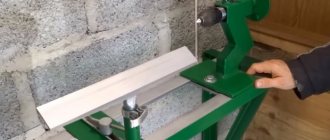Wet and dry wood
Wet wood usually processes better. The advantage is not only the simple and quick capture of material, but also the minimal dust formation during operation.
However, the resulting product will undergo major changes over time. Gradual drying can change the shape and size of the object. Rapid drying may even cause cracking.
Unlike fresh wood, when processing dry wood, you can count on stability of shape and final color. However, such turning work is more labor-intensive, but a number of modern devices solve this problem.
The lower availability and higher price of dried wood are also important.
Turning technology
Depending on the intention or the product to be produced, it is necessary to select a turning technique. The most common and simplest form is spindle turning, which is based on a cylindrical shape.
The firmly fixed material rotates smoothly around its axis, and special knives or planks shape the wood. In this way you make legs for chairs and tables, separate partitions for railings or fences.
Longitudinal or transverse turning will be used in the production of decorative elements or bowls, containers and toys. Here you can interestingly combine mechanical processing of the material from the outside with modification of the cavity inside the tree.
Other types of turning include, for example, annular, multi-axis or segment turning. However, for normal wood processing, knowledge of classical techniques and their combinations is sufficient.
- When working, pay attention to high-quality equipment. It’s definitely not worth saving on knives.
- High-quality, well-sharpened steel guarantees ease of use.
- The material under the blade will change smoothly and there will be no unevenness or unwanted edge abrasion.
- Choose knives, lathes, chisels only from high-quality manufacturers with the possibility of repeated grinding.
Quality knives are an investment, but it will come back to you soon. This will save your time, complex repairs of finished products and damaged material.
Decor, souvenirs, advertising, jewelry, etc.
The ability to process completely different materials using several strategies - 3D milling, cutting and engraving - allows you to use CNC milling in completely different areas and produce an endless variety of objects.
Possibilities of a CNC machine in the production of promotional products and decorative items
The use of a milling machine allows us to produce a wide variety of products: toppers and words for celebrations, photo frames, boxes, plaques and signs from various materials including plastics, wood, metals and artificial stone. By engraving two-layer plastics of various colors you can make signs, badges, license plates, and nameplates.
Workshop of Daria Shved https://.com/id232777509 (Krasnodar), aluminum machine Modelist90120al
1/8
Nikita T., (Perm), aluminum machine Modelist60120
1/8
(Ekaterinburg, Belinskogo str. 34, office 321, tel. 89122455596, 89028733571) is engaged in the manufacture of products for advertising activities, decoration of premises and furniture made of artificial stone, aluminum machine CNC-6090al
1/6
FROSTBERG company (Dmitrov, https://.com/frostberg_decor), aluminum machine CNC-6090al
1/4
Using a CNC machine to make jewelry
A collection of works on the manufacture of jewelry, costume jewelry and souvenirs is listed on a separate page
Here is an example of using a CNC machine to make jewelry. Alexey Yuvelirov (Gelendzhik, https://.com/gelengrav), machine cnc2535al2
1/7
Milling of model wax in 5 axes on a 5-axis CNC machine
Milling a ring from model wax using a specialized rotary device, which, together with a special software plugin, makes it quite easy to create models of rings of complex shapes that require processing both from the end and sides of the ring, an example of such a ring in the photo
video of making this ring on a CNC machine
Using a CNC machine in furniture production.
A collection of works from our users on the production of furniture decor, milling furniture fabric, etc. is included on a separate page
Milling machines can be used to process a wide variety of wood types. Using the machines, it is possible to create signs and indicators made of wood, prototypes, unique products, toys, molds for casting furniture fittings and much more.
(Gorokhovets, gorfurnitura.ru) is engaged in the production of furniture decor, aluminum machine CNC-6090al. The slide show uses photos of decor made using molds made on a CNC-6090al
1/8
Andrey E. (Rostov-on-Don), made boxes for his workshop on an aluminum CNC-3040al2 machine
Souvenir products.
A CNC machine allows you to make souvenirs, award diplomas, dedicatory inscriptions, engrave a wide variety of products made of plastic, glass and non-ferrous metal, including cups, medals, tokens, pendants, bottles, and much more.
Dmitry U. (Novosibirsk), plywood machine Modelist3040
1/9
Andrey E. (Rostov-on-Don), aluminum machine CNC-3040al2. Making molds for creating gift chocolate bars
1/2
Vitaly F. (Orel), plywood machine Modelist3030. Cookie mold
Sergey K. (Gagarin), plywood machine Modelist4060. Coat of arms, bottle packaging and night light Eiffel Tower
1/3
Alexey P. (Moscow), plywood machine Modelist3030
1/2
Sergey (Krasnodar), plywood machine Modelist4090. Making models for construction companies from PVC
Vladislav G. (Krasnodar), aluminum machine CNC-3040al2. Milling parts of RC models for drag racing
1/4
Using CNC for equipment production. Devices, printed circuit boards, cliches.
Using engraving and milling machines, you can produce instrument cases, panels, engrave inscriptions, signs, serial numbers on a wide variety of parts, from plates on equipment and instrument panels, to final products.
Andrey K. (Primorsko-Akhtarsk), aluminum machine CNC-3040al2. Engaged in the manufacture of devices for video operators and video cameras from duralumin alloys. In the photo POOLiRiG is a shoulder rest for various video cameras.
Konstantin K. (Krasnodar), aluminum machine CNC-2020al. Printed circuit board manufacturing
Alpha, LLC (Simferopol), aluminum machine CNC-2535al. Magnesium cliche
A collection of works on the production of molds, clichés, and sealers is included on a separate page.
Structure of a lathe
The universal center lathe is the most common lathe. The name of a lathe comes from two points between which the workpiece is clamped in the center.
The structural elements of a lathe can be divided into 5 main groups:
- Bed in the form of a massive cast base;
- Headstock and tailstock;
- Feeding device;
- Longitudinal or transverse support;
- Set of replacement gears;
- Transmission.
Some lathes are additionally equipped with an apron to drive the mechanisms.
Lathe bed
This is the main part of the lathe, it is shaped like a beam and is usually made of gray cast iron. The bed must be rigid and strong enough to support the weight of other parts of the lathe, not bend, and withstand the forces encountered during turning.
- The lathe bed is usually mounted on two frame legs.
- The left leg mainly hides the engine and gearbox, the right one serves as a toolbox.
- At the top of the bed there is a guide for the support and tailstock.
- The feeder slides on outer guide surfaces and the tailstock slides on inner guide surfaces.
Due to possible damage, tools and semi-finished products are not placed on it; storage compartments are provided for this purpose.
Lathe headstock
It is a hollow shaft mounted in bearings designed to prevent bending of the spindle and maintain the pressure generated during machining.
- The front and rear main bearings (sliding) perceive pressure perpendicular to the spindle axis.
- These pressures are also called radial pressures.
- The pressure in the direction of the spindle axis (axial pressure) is absorbed by the rolling bearing.
- The spindle and headstock should not vibrate during operation.
Most lathes have a box-shaped headstock (in exceptional cases they are cylindrical).
The right end of the spindle protrudes from the headstock and has a thread on the outer end to which a clamp is screwed for clamping the workpiece. The main part of the headstock is the spindle.
Spindle
The spindle is driven by a motor, which, as already mentioned, is installed in the left rack of the lathe. The motor shaft has a drive pulley with grooves for drive belts that transmit motion to the driven pulley and the gearbox.
- A gearbox has multiple gears, and the movement of the sliding gears changes the gears and therefore the speed of the drive pulley.
- The movement from the drive pulley is transmitted by a wide flat belt to a pulley in the headstock.
- The pulley is mounted on a housing mounted on two ball bearings.
The spindle passes freely through the housing and can be connected to it using a coupling or gear template.
Feeder
During turning, the knife is moved manually or mechanically, radially and axially relative to the workpiece. The feeder is driven by a shaft and replaceable gears. The movement is transmitted to gears in the feed reducer.
Shifting gears changes the speed at which the blade feeds when turning.
- In the feed mechanism, the gears are divided into three groups I, II, III. In Part I, the gears are changed by moving the sliding gears using a flywheel.
- Part II introduces the Norton gear, which is driven by an intermediate shaft on which is mounted a wide pinion, with which the pinion is constantly in mesh, mounted on a swing arm.
Wood turning is a beautiful and creative activity. It takes some skill, but with quality equipment and a powerful lathe, you can master the basic techniques relatively quickly.
In addition, treated wood is widely used. You can equip or complement it with conventional furniture production, it will also serve as a practical accessory in the interior and exterior.
Vase
How can you make a vase on a lathe?
To make it, you may need a certain tool. In addition to the lathe, you need to take cutters, a plane, a hacksaw, a ruler, a compass, an ax and a saw, sanding paper and a chisel. The process of turning a vase is extremely simple. True, it should be noted that vases can be complex in configuration and simple. Let's look at how you can carve a simple option.
- First, a block of wood 10-20 cm long is cut out with a saw.
- It must be trimmed with a plane, both from the ends and along the length.
- The workpiece is installed in the machine chuck.
- The machine is turned on and checked for runout of the part.
- If it is present, alignment must be carried out.
- The top layer of wood is removed to a depth of 1 cm.
- A chamfer is removed at an angle of 45° from the outer end.
- A drill is inserted into the tailstock.
- A hole is drilled with a depth less than the length of the workpiece by 3-5 cm. That is, the bottom of the vase is determined.
- Now, using a cutting tool called a jamb, the cavity of the product is cut out.
Since the vase can have different shapes: straight, oval, and so on, the boring of the upper surface is accordingly maintained in the exact shape. After which the product is polished outside and inside. What is sandpaper used for? The wooden product is removed from the machine, the bottom is finished by hand using a plane and sandpaper. After which the souvenir is varnished.
This is interesting: Foundation for a lathe - we present it in detail

